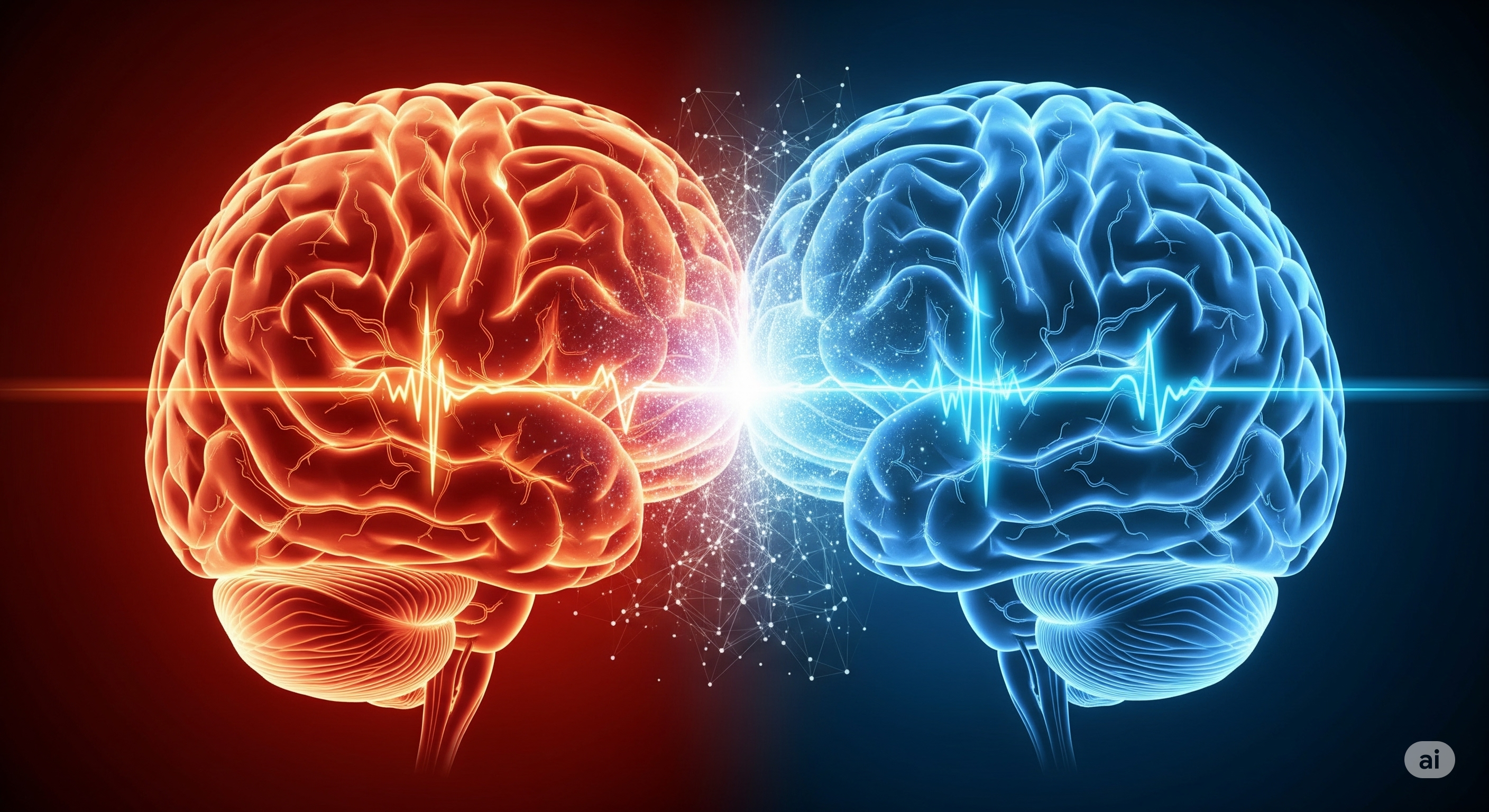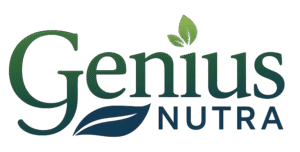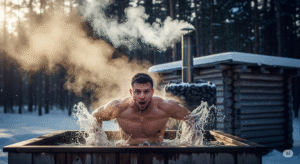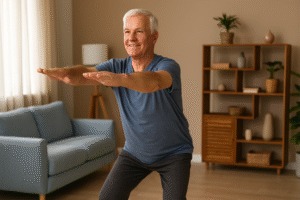A health revolution is underway in America—and it’s not being led by the latest supplement or diet trend. Instead, it’s happening in backyards, boutique wellness studios, and elite performance centers through an ancient yet scientifically revitalized method: cold plunge and sauna therapy.
This hot-cold combination, also called contrast therapy, is capturing attention not just for its invigorating sensation, but for its documented benefits in recovery, immunity, mental clarity, and even metabolic health. From athletes to overworked professionals, more people are discovering how this pairing can unlock better physical and mental performance.
In this article, we’ll explore the science, rituals, and strategies behind cold plunge and sauna use, and why this contrast therapy duo is quickly becoming a cornerstone of modern wellness. Whether you’re curious about reducing inflammation, improving circulation, or enhancing longevity, this deep dive will provide the insights—and the evidence—you need.
What Is Contrast Therapy? The Ancient Wisdom Backed by Modern Science
Contrast therapy refers to the alternating use of hot and cold treatments to stimulate physical and psychological benefits. While versions of it have existed for thousands of years (think Nordic bathhouses or Japanese onsens), modern versions use high-temperature saunas and cold water immersion tanks to create a powerful physiological shock effect.
How Contrast Therapy Works
The core mechanism lies in vascular gymnastics: alternating hot and cold exposure causes vasodilation (expanding blood vessels) followed by vasoconstriction (narrowing them). This push-pull dynamic acts like a pump for your circulatory and lymphatic systems, helping flush toxins, reduce inflammation, and stimulate cellular repair.
- Heat exposure increases circulation, relaxes muscles, and triggers heat-shock proteins that protect and repair cells.
- Cold exposure activates the sympathetic nervous system, reducing inflammation, sharpening focus, and increasing norepinephrine levels—key for mood and alertness.
💡 Quick Tip: For optimal results, most practitioners recommend a 3:1 ratio—3 minutes cold plunge for every 1 minute of sauna or vice versa, depending on your goal (relaxation vs stimulation).
Scientific Support for Contrast Therapy
Emerging evidence is stacking up:
- A 2019 study published in Temperature journal found that contrast therapy significantly reduced muscle soreness and perceived fatigue in athletes compared to passive recovery.
- Finnish research involving over 2,000 participants linked regular sauna use with a 65% reduced risk of Alzheimer’s and lower cardiovascular mortality.
- Cold immersion alone has been shown to elevate dopamine levels by up to 250%, promoting mental clarity and focus long after exposure.
Did You Know? NASA has studied temperature extremes to simulate stress adaptations in astronauts. The same hormetic effects of contrast therapy mimic this concept—controlled stress = stronger resilience.
The Hormesis Principle — Stress That Heals
Hormesis is a biological phenomenon where low-level exposure to stressors (like heat or cold) leads to enhanced health, strength, and longevity. It’s why lifting weights builds muscles—and why cycling between hot saunas and cold plunges can supercharge your body’s adaptability.
Nervous System Reset — Why You Feel So Clear After
Alternating heat and cold stimulates the vagus nerve and helps regulate the autonomic nervous system. This can:
- Reduce anxiety
- Improve sleep quality
- Rebalance cortisol rhythms
In other words, you’re not just “relaxing”—you’re retraining your stress response.
Physical Health Benefits: Recovery, Circulation, and Immunity Unleashed
While the invigorating feeling of contrast therapy is reason enough for many to commit, it’s the measurable physical benefits that make this ritual a true game-changer. From muscle repair to immune system enhancement, the cold plunge + sauna combo delivers targeted physiological advantages that science is just beginning to fully understand.
Faster Recovery and Reduced Muscle Soreness
Recovery is one of the most cited reasons athletes use cold plunge and sauna. The heat helps relax tight muscles and flush metabolic waste, while the cold reduces inflammation and speeds healing. This two-pronged effect creates ideal conditions for muscle repair and regeneration.
Key benefits:
- Decreased Delayed Onset Muscle Soreness (DOMS)
- Faster repair of microtears from resistance training
- Enhanced lactic acid clearance via lymphatic pumping
✅ Expert Summary: A 2021 study published in Frontiers in Physiology found that contrast therapy improved recovery markers like creatine kinase and inflammation levels more effectively than passive rest after high-intensity exercise.
Improved Circulation and Cardiovascular Health
One of the lesser-known but incredibly powerful effects of contrast therapy is its impact on blood flow dynamics. The alternating temperatures train blood vessels to expand and contract, strengthening vascular walls and enhancing overall circulation.

Thermal cycling can:
- Increase cardiac output by up to 30% during sauna use
- Stimulate endothelial repair via nitric oxide production
- Reduce arterial stiffness over time
📌 Did You Know? According to the Journal of Human Hypertension, sauna bathing 4–7 times a week reduces blood pressure and arterial plaque formation, especially in adults over 45.
Immune System Stimulation
Cold exposure has been shown to activate white blood cell production, including natural killer (NK) cells responsible for eliminating pathogens and rogue cells. Sauna sessions also raise core temperature, creating a mild artificial fever that stimulates immune resilience.
Together, this combo:
- Increases leukocyte and monocyte counts
- Enhances response to viral and bacterial infections
- Reduces inflammatory cytokines (especially IL-6 and TNF-alpha)
💡 Quick Tip: Doing contrast therapy consistently (3–4x per week) appears to compound immune benefits. For best results, time your sessions in the evening to support melatonin production post-therapy.
| Benefit | Cold Plunge | Sauna | Combined Effect |
|---|---|---|---|
| Muscle Recovery | Reduces inflammation and soreness | Enhances circulation and muscle repair | Speeds up total recovery time significantly |
| Circulation & Heart Health | Vasoconstriction training | Vasodilation stimulation | Improves vascular tone and heart efficiency |
| Immune Function | Increases white blood cells | Raises core temperature for immune activation | Strengthens immune defense response |
| Hormonal Balance | Boosts dopamine and norepinephrine | Triggers growth hormone and BDNF | Optimizes stress response and neurochemistry |
Alt Text: Sauna and cold plunge work together to boost muscle recovery, circulation, immunity, and mental focus.
Mental Clarity, Mood & Brain Health: How Heat and Cold Reshape Your Mind
Beyond the physical, contrast therapy exerts profound effects on the brain. From reducing stress and anxiety to boosting cognitive performance and emotional regulation, alternating between hot and cold exposure stimulates key areas of the nervous system that modern lifestyles often neglect.
The Neurochemical Reset — Dopamine, Norepinephrine & Serotonin
When you immerse yourself in cold water, the body initiates a neurochemical cascade—notably, a surge in dopamine, norepinephrine, and beta-endorphins. These are the same brain chemicals responsible for motivation, alertness, and pleasure.
Research highlights:
- A 2020 study in Neuroscience Letters found that a single cold immersion can increase dopamine levels by 250% and keep them elevated for hours.
- Sauna exposure increases prolactin and brain-derived neurotrophic factor (BDNF)—both linked to learning, memory, and neuron growth.
✅ Expert Summary: Combining sauna (parasympathetic activation) with cold plunge (sympathetic activation) creates a hormetic brain training that increases stress tolerance and sharpens focus—without pharmaceuticals.
Reduced Stress and Anxiety via Vagal Activation
Cold water immersion activates the vagus nerve, which plays a central role in regulating the parasympathetic nervous system (PNS)—responsible for “rest and digest” states.

This means:
- Decreased heart rate variability (HRV) = better stress resilience
- Reduced anxiety symptoms in individuals with high cortisol
- Improved emotional regulation and sleep quality
💡 Quick Tip: Exhaling slowly during cold plunge exposure helps accelerate vagus nerve stimulation, leading to quicker mental calm and stronger resilience.
Enhanced Sleep and Melatonin Production
Many users report that contrast therapy in the evening enhances sleep. This is more than placebo. Sauna use raises core temperature, and the subsequent drop post-session mirrors the natural circadian rhythm that prepares the body for deep sleep.
- Cold plunges trigger melatonin precursors via thermoregulatory feedback loops
- Evening sessions reduce nighttime cortisol and improve sleep efficiency scores
📌 Did You Know? Cold exposure stimulates brown fat activation, which helps maintain thermogenic stability overnight—meaning fewer wakeups and deeper REM cycles.
Long-Term Brain Health and Neuroprotection

Contrast therapy may also offer neuroprotective effects. Emerging data suggest that intermittent heat and cold stress stimulates BDNF, reduces brain inflammation, and protects neurons against age-related damage.
- May reduce risk of neurodegenerative diseases (Alzheimer’s, Parkinson’s)
- Supports synaptic plasticity and new neuron formation
- Enhances mitochondrial efficiency in brain cells
A longitudinal Finnish study of over 2,300 men showed that those who used saunas 4–7 times per week had 66% lower risk of dementia and 65% lower risk of Alzheimer’s compared to those who used saunas once a week.
What the Research Says
How to Build a Contrast Therapy Routine: At Home or at the Spa
Understanding the science is just the first step. To fully experience the benefits of contrast therapy, you need a structured, safe, and consistent routine. This section will guide you through creating a practical protocol—whether you have access to a professional spa, gym facilities, or you’re building a DIY setup at home.
At-Home Setup — What You Need to Get Started
You don’t need a luxury spa to start contrast therapy. With the rising popularity, more Americans are installing personal saunas and cold plunges, or improvising with bathtubs and ice.
Basic home setup options:
- Cold Plunge: Ice bath, chest freezer (insulated and regulated), or dedicated cold plunge tub (e.g., Plunge, Renu Therapy).
- Heat Source: Infrared sauna, traditional dry sauna, or even a hot shower/steam room.
Safety musts:
- Water temp: 50°F to 59°F (cold), 160°F to 195°F (sauna)
- Session time: 10–15 min sauna, 2–5 min cold plunge
- Ratio: 3:1 (heat:cold) for relaxation, 1:3 for stimulation
💡 Quick Tip: If you’re new, start with shorter exposures (2 min cold, 5 min heat) and gradually build tolerance. Never do contrast therapy alone if you’re just starting.
Gym or Wellness Center Protocol
Many U.S.-based gyms (Equinox, Life Time, Restore Hyper Wellness) now offer contrast therapy as a premium recovery service. If you’re using a facility:
Recommended protocol:
- Warm up with 10–12 minutes in the sauna
- Transition to 2–3 minutes cold plunge
- Repeat for 2–3 cycles, ending with cold
- Hydrate with electrolytes post-session
✅ Expert Summary: Ending on cold is ideal if your goal is alertness and muscle recovery. If aiming for relaxation and better sleep, end on heat to promote parasympathetic dominance.
Tailoring Frequency to Your Goals
Your weekly schedule should reflect your primary wellness goal:
| Goal | Frequency | Ideal Timing |
|---|---|---|
| Muscle Recovery | 3–5 sessions/week | Post-workout (within 1 hr) |
| Mental Clarity | 2–4 sessions/week | Morning (fasted or pre-work) |
| Immunity & Longevity | 4–6 sessions/week | Evenings or weekends |
| Stress/Anxiety Relief | 3–5 sessions/week | Evening or before bed |
Alt Text: Tabela mostrando a frequência semanal recomendada e o momento ideal para atingir objetivos como recuperação muscular, clareza mental e alívio do estresse.
📌 Did You Know? Even a single contrast therapy session can lower cortisol for up to 24 hours—but daily use compounds benefits over time, especially for mood, sleep, and HRV.
Important Safety Considerations
- Always consult your physician if you have cardiovascular issues, high blood pressure, or neurological conditions.
- Never perform cold plunge after alcohol, while fasting for extended periods, or when sleep-deprived.
- Avoid staying in cold water past shivering — this indicates your body is losing too much heat.
Warning Sign: If you feel lightheaded, overly fatigued, or confused post-session, stop immediately and warm up. Contrast therapy should feel intense, not dangerous.
What the Research Says: Clinical Evidence Behind Cold Plunge + Sauna
While anecdotal support for contrast therapy is widespread, it’s the growing body of peer-reviewed research that validates this practice as more than just wellness hype. From inflammation to neurobiology, multiple studies now back up the claims surrounding sauna and cold immersion therapy.
Sauna Use Reduces Cardiovascular and Neurological Risk
One of the most robust data sets comes from Finnish longitudinal studies, where sauna culture is deeply ingrained. A 2015 study in JAMA Internal Medicine followed over 2,300 men for 20 years and found:
- 50% lower risk of cardiovascular-related death in those using the sauna 4–7 times/week
- 66% lower risk of Alzheimer’s and dementia in frequent sauna users
Source: NIH / PubMed Study
Another review in Experimental Gerontology confirmed the neuroprotective effects of heat exposure, particularly in stimulating brain-derived neurotrophic factor (BDNF), crucial for memory and learning.
Cold Water Immersion Enhances Immune Function and Mood
A study published in PLoS ONE in 2016 showed that people who took daily cold showers were 29% less likely to call in sick for work compared to a control group.
Source: PubMed – Cold Showers and Illness Absence
In addition, a 2000 study from the European Journal of Applied Physiology found that cold water immersion led to a significant increase in norepinephrine and a moderate rise in dopamine—neurotransmitters tied to alertness and mood.
Source: Healthline – Cold Therapy and Neurochemicals
✅ Expert Summary: Short-term cold exposure creates an anti-inflammatory hormonal cascade, increases white blood cell count, and boosts dopamine levels by up to 250%.
Combined Heat + Cold Therapy Accelerates Recovery
The synergy between sauna and cold exposure may be even more powerful than either therapy alone. A 2019 study in Frontiers in Physiology found that contrast therapy reduced muscle soreness and accelerated lactate clearance after high-intensity resistance training.
Source: NIH – Contrast Water Therapy
Another randomized controlled trial showed improved creatine kinase clearance (a marker of muscle damage) and faster return to baseline performance compared to passive rest.
📌 Did You Know? Contrast therapy can increase mitochondrial biogenesis—your body’s way of creating more energy-producing cells—which has implications for endurance, longevity, and metabolism.
Summary Table — Research Highlights
| Study | Finding | Source |
|---|---|---|
| Laukkanen et al., 2015 (Finland) | Sauna 4–7x/week = 50% lower heart-related death | PubMed |
| Buijze et al., 2016 (Netherlands) | Cold showers reduce sick leave by 29% | PubMed |
| Frontiers in Physiology, 2019 | Contrast therapy reduces soreness & speeds recovery | NIH |
| Healthline Summary, 2022 | Cold exposure raises dopamine and norepinephrine | Healthline |
The Science Behind Cold Plunges, Explained in Four Minutes
Conclusion: Hot, Cold, and Health Transformed
The resurgence of cold plunge and sauna therapy is more than a wellness trend—it’s a scientifically supported, physically and mentally revitalizing practice. By embracing the controlled contrast of heat and cold, you’re not just relaxing—you’re enhancing cardiovascular resilience, balancing neurochemistry, reducing inflammation, and unlocking a deeper sense of clarity and recovery.
Whether you’re a high-performing athlete, a stressed professional, or simply someone who values optimal health, this power combo offers a simple, natural, and profoundly effective tool for lifelong wellness.
Cold plunge and sauna are reshaping the way Americans approach recovery, immunity, and brain health. And the best part? You can start with just a tub of ice and a hot shower.
Main Takeaways
- Contrast therapy uses alternating heat and cold to promote physical and mental health.
- Cold plunges reduce inflammation, elevate dopamine, and stimulate immunity.
- Sauna use improves cardiovascular health, aids detoxification, and protects brain function.
- Combined therapy enhances recovery speed, mood regulation, and sleep quality.
- Routine matters: frequency and duration should match your specific health goals.
- Scientific studies confirm contrast therapy benefits across immunity, cognition, and longevity.
FAQ – Frequently Asked Questions
Is it better to do cold plunge before or after sauna?
It depends on your goal. Ending with cold increases alertness and reduces inflammation. Ending with heat promotes relaxation and better sleep. Most people alternate 2–3 rounds, beginning with heat and ending based on personal needs.
How many times a week should I do contrast therapy?
Three to five times per week works best for recovery, mood, and immune benefits. New users can start with twice a week and increase gradually. The key is consistency over intensity.
Does cold plunge boost your immune system?
Yes. Cold exposure activates white blood cells and reduces inflammation. Regular sessions are linked to fewer sick days and better resistance to seasonal infections.
Can I use sauna and cold plunge every day?
Daily use is generally safe if you’re healthy and gradually build up exposure. Just make sure to hydrate, avoid extremes, and listen to your body’s signals.
Will contrast therapy help with fat loss?
Indirectly, yes. Cold plunges activate brown fat, which burns calories, and saunas improve insulin sensitivity. Over time, this supports better metabolic function and fat-burning potential.
🔗 Further Reading You’ll Love
🚶 Rewire Your Body with Ancient Simplicity
Discover the powerful cardiovascular and mental benefits of Japanese Walking. It’s slow, effective, and transformative.
👉 Japanese Walking: The Fitness Secret with Centuries of Proof
🔥 Maximize Fat Loss with Precision Treadmill Training
Looking for a routine that burns fat without burning out? Learn why the 12-3-30 method is revolutionizing indoor cardio.
👉 12-3-30 Treadmill Method: Science-Based Fat Loss Routine
🌿 The Superfood Your Recovery May Be Missing
Find out how Moringa supports inflammation control and nutrient absorption—perfect post-sauna nutrition.
👉 Moringa Magic: Full Review + Recovery Benefits







